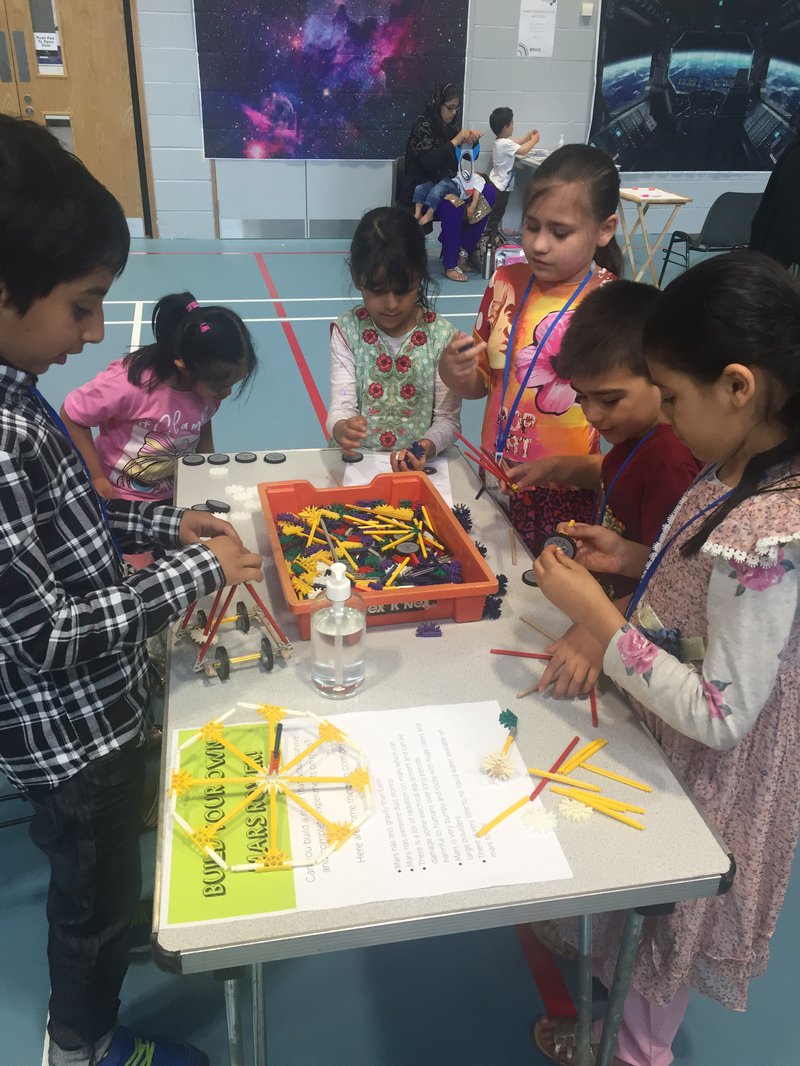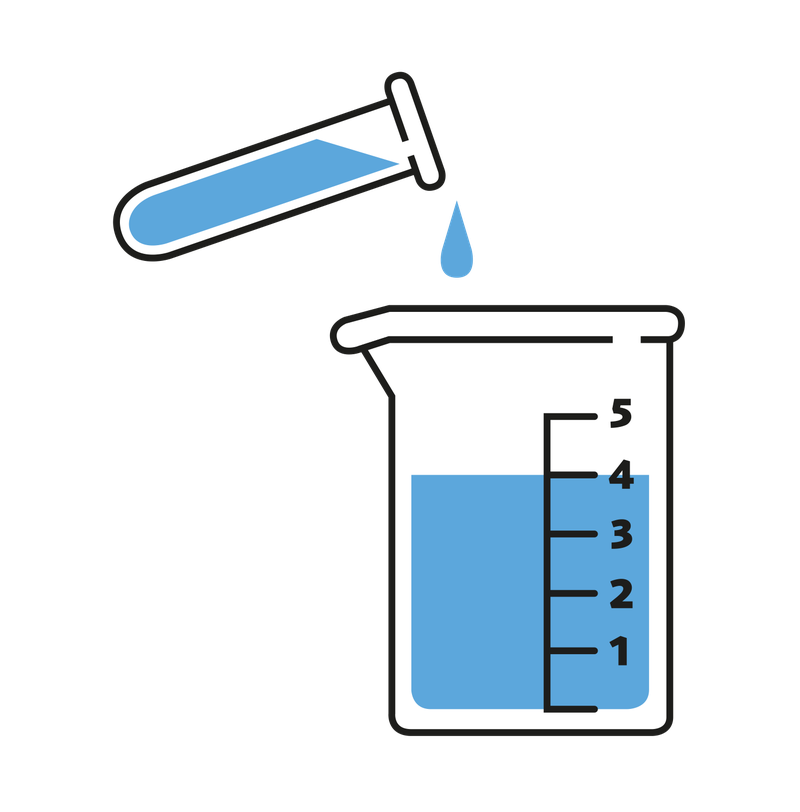Sanctuary Housing and Science Oxford
Science Oxford partnered with Sanctuary Housing, a not-for-profit housing association.
Who did you work with?
Our community partner for this project was Sanctuary Housing, a not-for-profit housing association. Under the umbrella of Sanctuary Housing, we partnered with three Banbury youth groups, working with young people and their families in the local community. We ran workshops for each youth group separately, then took the opportunity to bring all three together for the final showcase day. The youth groups operate in three different locations in Banbury at The Hill, Grimsbury and the Mosque.
Had you worked together before?
We’ve previously worked with some of the youth groups in Banbury as part of a larger project, and have visited them to run workshops for small groups of young people. We saw Explore Your Universe as an opportunity to maintain and build on our existing relationship with these communities.
“For some of the kids in this group it was the first time they had been away from their parents since lockdown”
Youth Leader

What goals, values or priorities did you share with your partner that meant you worked well together?
We certainly have a shared goal with the youth groups in terms of providing opportunities for young people. We worked together to reduce the barriers for young people and their families who attended and to ensure everyone felt valued and welcome.
Can you summarise the aims of your project delivery in 2(ish) sentences?
The aim of our project was to engage young people and their families using our planetarium to inspire the young people to develop and present their very own planetarium show, linking to STFC science. We collaborated closely with the youth club leaders to find out what would work best for the families they work with, and by providing workshops for the youth clubs and a showcase event in their own venue we wanted everyone to see that science was ‘for them’!

How co-produced was your programme?
- Information shared (the offer is decided and provided by you as the lead partner and people join to hear information)
- Consultation (the community partner/participants choose from a range of options, involving listening, feedback and discussion, but broader project objectives and delivery are led by you)
- Deciding together (community partners/participants support the creation and design phase, bringing new options and joint decision-making. Delivery and evaluation/reporting is led by you as the lead partner)
- Acting together (involvement of community partner/participant at each stage - from the planning and design, to the delivery and evaluation – with shared decision-making that forms a partnership to carry out the full programme)
- Supporting independent community interest (supporting partner agency, including offered funding, advice, and support to develop the independent ideas and agendas of the community partner).
We worked very closely with Sanctuary Housing and the leaders of each youth group to learn more about how they operate in their community, and suggested some activities and projects which we thought might work. Based on a number of suggested ideas, our community partners identified which activities would work best for their young people. The plans and timescales for the programme changed considerably due to COVID-19, but the final plan was a joint decision with our community partners, particularly in terms of the format, timing and venue of the workshops. Delivery on the day was a joint effort between youth leaders, who organised many of the practical arrangements, and Science Oxford staff who supported with the planetarium workshops.
“We had a great time – they will sleep well tonight on the way home!”
Parent
Can you note down some of the benefits and challenges to working this way?
The project was very much a team effort between our community partners and Science Oxford, which meant that everyone was focussed on providing enjoyable and inspiring days for the young people and their families. Our youth leaders were incredibly enthusiastic and supportive from the start of the project, which helped immensely in encouraging families to attend, helping them feel welcome and that the activities were something they were part of rather than being presented to them.
The main challenges were around needing to be flexible and open to making changes to plans. For Science Oxford staff, we were working in an unfamiliar venue with young people covering a wide range of ages and interests. For our community partners, this type of event was new to them too!
What was the science link?
During the planetarium workshops, the young people found out about space and the solar system, focussing on topics such as the vastness of the universe, constellations and the planets. An important part of the workshops included developing ‘soft skills’ such as presenting to an audience and working together. Later, when families joined the youth group members for their celebration showcase day, we included further activities linked to space such as building a mars rover, linking to STFC science and possible future STEM careers.

What happened?
In summary, our project encompassed full day workshops with each of the three youth clubs during a single week of the summer holidays, followed by a further celebration day bringing everyone together where the young people presented the planetarium shows they had practised and prepared to their families in small groups. Finally, a couple of weeks later, all of the families were invited to a special day visit to the Science Oxford Centre, with transport provided, where they were able to spend time in our hands-on Exploration Zone and try our woodland trails.
On the day of the first workshop, the youth leaders and Science Oxford team waited with a certain amount of trepidation for the young people to arrive. Would anyone turn up? Would they be interested or bored? Would they be silent or noisy?! We needn’t have been concerned – a significant advantage of running the activities at a venue the young people knew was that the location felt welcoming and familiar. Soon they were chatting and asking what was planned for the day.
The day began with an activity to put the planets in the solar system in order – many of the young people could draw upon some knowledge of the planets and worked together to do this. This was followed by a planetarium show for them to experience the amazing images of space and the planets for themselves.
A workshop focussing on presenting skills was potentially a challenging activity, but we were delighted that everyone took part and had a go! After lunch everyone worked in groups and rotated around different activities including developing and practising their own planetarium show, decorating lanyard badges and colouring our specially-designed evaluations.
Particular highlights noted by our team included:
- the enthusiasm of all the young people taking part
- break-throughs with some of the quieter children through chatting with them individually
- talking to children about their particular interests, not necessarily related to space (for example the science of the oceans!)
- some of the children’s first reactions to the images of the night sky
- seeing the confidence of some of the quieter girls increase as they presented and shared what they had enjoyed
- whole families enjoying the activities together and families from different areas in Banbury coming together to enjoy the showcase and celebration days.
Some of the children came up with some fantastic space questions for us, including:
“When will we discover light travel?”, “What is astronomy?”, “Why does space have so much space?”, and “Why is space black and dark?”
What challenges might lie in wait for someone wanting to replicate this project?
Some of the challenges for us included keeping children with a wide range of ages fully engaged throughout the day, and managing the behaviour of some groups when we didn’t know the young people well. Some families arrived at different times and we were keen to make sure they were greeted and made welcome. We also noted that with a group of families with different aged children the planetarium can be quite noisy!
Were there any surprises?
Overall the surprises were positive! We were surprised how well the children adapted to new experiences and new people, despite the effect of recent lockdowns limiting the opportunities to attend their youth groups and any other activities. We were surprised at the different dynamics of the groups we worked with, and needed to be flexible as we worked with them. Some children amazed us with their knowledge of space and the solar system, others with their willingness to have a go and do something new. We were also surprised at how many young people manged to bring their families along to the family showcase day!
“It has been difficult in the past to integrate these 3 communities but it felt like it happened today”
Youth Leader
How did you capture/measure the impact for this project?
Our evaluation plan included a number of simple activities. To find out their attitudes towards science we used a space-themed voting system and asked the young people to place a star in a voting box which best matched how they felt. This was linked to the initial activity around ordering the planets in the solar system:
Mercury = Hot = “I really like Science and I think it is something I can do (It’s for me!)”
Earth = warm = “I sort of like science and I am sort of good at it”
Neptune = cold = “I don’t really like science and I am not very good at it (It’s not for me)”
Later in the afternoon, the young people coloured an alien emoji sheet to indicate how they felt about the day, and finally drew or wrote something to express ‘What would you tell your friends about today?’
During the family showcase event, everyone was invited to place stickers or post-it notes to indicate on a scale or provide comments on posters around the hall, answering questions such as ‘Are you interested in hearing about new science discoveries?’, ‘Do you think the child you are with today would like to work in science when they are older?’ and ‘What worked well / what were the challenges today?’
Additionally, Science Oxford staff completed reflection diaries and spoke with our community partners at the end of each day to collect feedback comments and thoughts.
Where is the long-lasting change?
The project allowed us to further grow our relationship with our community partners and we are all keen to keep this partnership developing in the future. The project plan had to be changed many times due to the impact of COVID-19 and we were delighted (and relieved!) when the workshops and family days eventually went ahead.
We have already worked with our partner Sanctuary Housing to host a further two family days at the Science Oxford Centre where they were able to invite more families from the Banbury area to attend, free of charge, during the summer holidays. Having developed a trusting relationship and an understanding of each other’s organisations, aims and challenges, we are very hopeful we will continue to work together in the future. Additionally, as part of our own staff development, the Explore Your Universe project has enabled us to hold Equality Diversity and Inclusion (EDI) training and initiated an EDI Working Group with representatives from across our organisation.
Please see below the Evaluation Report: Relationship + Engagement = Impact, Lessons learned from the evaluation of Explore Your Universe 4 written by Jen DeWitt.
